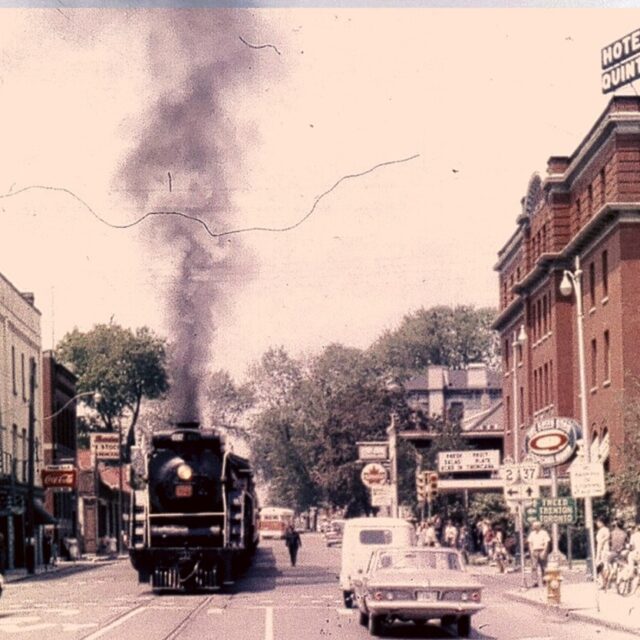
From Tracks to Transit- Belleville’s Transportation Story
Author: Connie Carson
Connie is a well-known local story-teller and professional who has a passion for the history of the City of Belleville, in particular, the downtown streets.
From Tracks to Transit- Belleville’s Transportation Story
Once upon a time, trains and even streetcars ran right through the heart of downtown Belleville. Long before buses and cars took over, the city pulsed with the sounds of wood burning locomotives, horse hooves, and humming streetcars, all helping to shape a growing, ambitious community.
The story begins in 1876 with the Bay City Street Railway, which operated until 1891. At the same time, the Grand Junction Railway brought trains right into the core of the city, with tracks running from Station Street down Great St. James and along Pinnacle to the Belleville Harbour. Freight cars carried lumber, produce, and people, and by June 24, 1877, the first passenger train departed from downtown heading for Stirling. It took three more years before the line reached Peterborough.
With no central terminal at the time, passengers and market vendors had to detrain at the Station Street depot, transfer to a streetcar, and pay again to continue to the harbour. Eventually, the railway shifted its tracks to the centre of Pinnacle Street, creating a main interchange with the Grand Trunk Railway. The final freight train rolled through on June 16, 1964, followed a week later by the last passenger trip. Soon after, the rails were pulled up, the pavement was laid, and train traffic downtown was gone.
But while trains roared on Pinnacle, trolleys trotted down Front.
In 1877, horse-drawn streetcars began carrying passengers from the Docters Hotel (beside the Grand Trunk Station) down Station and Front Streets to the Government Docks. Five enclosed cars were pulled by a team of sixteen horses, housed in a large barn near the station. They operated daily from 6 a.m. to 10 p.m., with tickets priced at 6 for 25 cents.
During winter, passengers nestled in around a coal-burning stove while straw on the floor kept their feet warm. Market days were particularly lively and trolleys packed with shoppers arriving by ferry from Prince Edward County added to the buzz of downtown. This simple but effective system became part of Belleville’s daily rhythm, until 1891, when a fire destroyed the streetcars and barns, bringing the era of horse-drawn transit to a sudden halt.
By 1895, the city embraced a new innovation: ELECTRIC STREETCARS operated by the Belleville Traction Company. With steel tracks laid and electric poles installed; a more modern system emerged. The new electric streetcars ran the same route as their horse drawn predecessors, from the train station to the waterfront, offering a smoother, faster ride. Each car towed an open-air trailer, picking up ferry passengers and downtown workers alike. The electric streetcars operated until 1901 before shutting down due to financial challenges.
In the early 1900s, Belleville saw the rise of jitney cabs—informal, low-cost rides that were quick but often unpredictable. By the 1920s, motorized buses took over, first through the Rawson Bus Company, which served the city until 1960. Today, Belleville Transit continues the tradition. Unlike fixed rail systems, buses offered flexibility; easily adjusting to new routes, expanding neighbourhoods, and the city’s growing needs Over
time, buses became the backbone of public transit, alongside cars, bikes, and regional rail.
Though the rails are long gone, the spirit of the streetcar still lingers on Front Street. Market Square and the vibrant new Memorial Market continue to buzz with life, echoing the energy of trolley days gone by. And while the ferries no longer dock at the harbour, Belleville’s waterfront remains a place of movement and momentum; a historic hub with its sights set firmly on the future.







